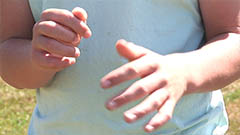Types of Video Shot
There is a convention in the video, film and television industries which assigns names and guidelines to common types of shots, framing and picture composition. The list below briefly describes the most common shot types (click the images for more details).
Notes:
- The exact terminology varies between production environments but the basic principles are the same.
- Shots are usually described in relation to a particular subject. In most of the examples below, the subject is the boy.
- See below for more information and related tutorials.
EWS (Extreme Wide Shot)

The view is so far from the subject that he isn't even visible. Often used as an establishing shot.

The view is so far from the subject that he isn't even visible. Often used as an establishing shot.
VWS (Very Wide Shot)

The subject is visible (barely), but the emphasis is still on placing him in his environment.

The subject is visible (barely), but the emphasis is still on placing him in his environment.
WS (Wide Shot)

The subject takes up the full frame, or at least as much as comfortably possible.
AKA: long shot, full shot.

The subject takes up the full frame, or at least as much as comfortably possible.
AKA: long shot, full shot.
MS (Mid Shot)

Shows some part of the subject in more detail while still giving an impression of the whole subject.

Shows some part of the subject in more detail while still giving an impression of the whole subject.
Weather Shot

The subject is the weather. Can be used for other purposes, e.g. background for graphics.

The subject is the weather. Can be used for other purposes, e.g. background for graphics.









